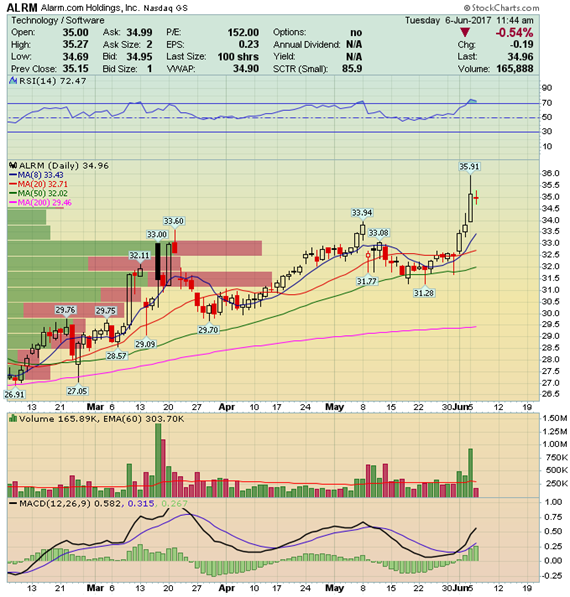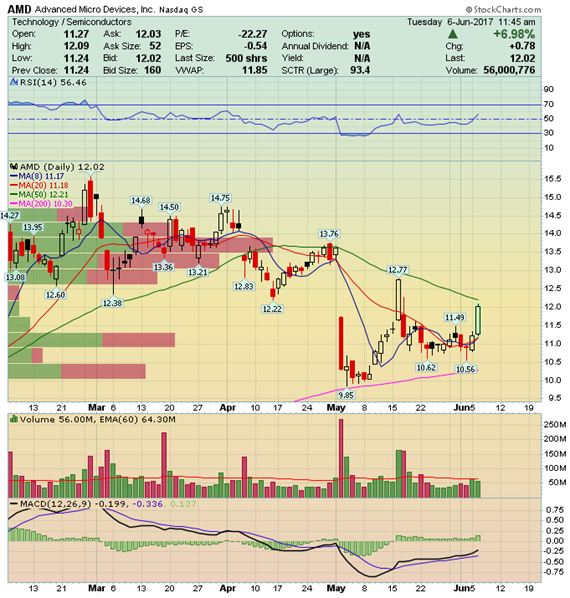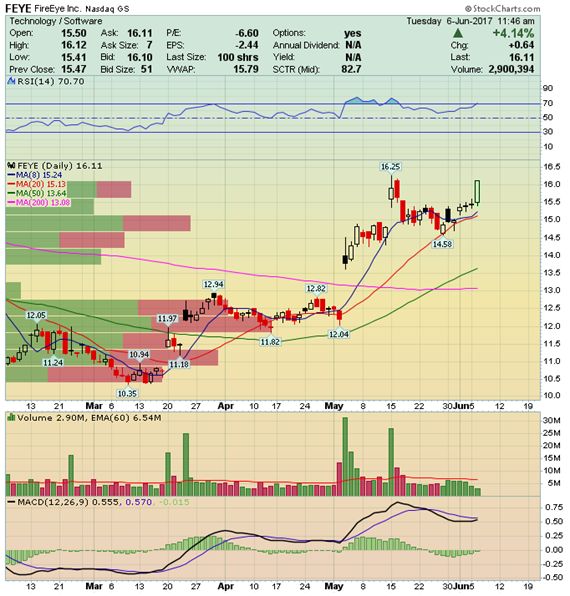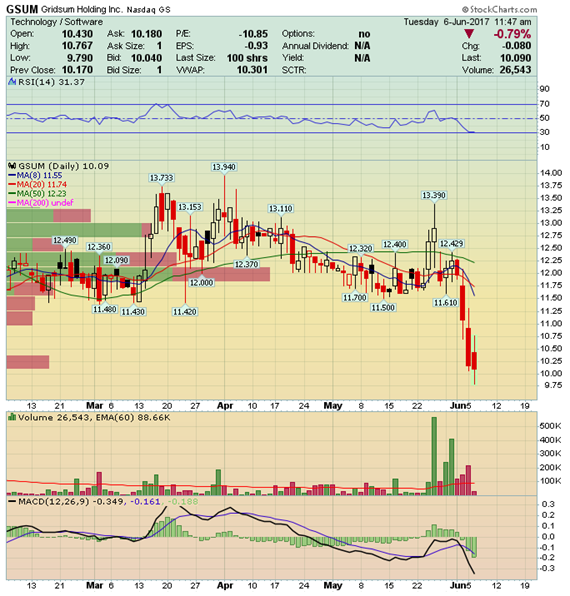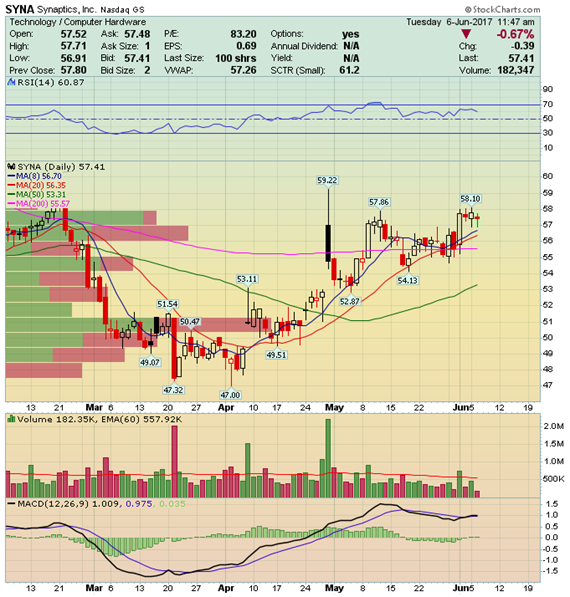Stifel Tech Conference Takeaways
Yesterday, a number of companies presented at the Stifel Technology, Internet & Media Conference. Below, you will find some takeaways from a select list of stocks.
Alarm.com (ALRM) – CFO Steve Valenzuela (who recently joined the company in November) provided the following commentary:
• Alarm.com closed two recent acquisitions, iControl and ObjectVideo, on 3/8/17 and 3/13/17, respectively. While still early, Alarm.com is pleased with initial integration efforts, expects harmonization to be substantially completed by the end of the year, and notes prior NTM guidance expectations around iControl remain on track.
• Mr. Valenzuela highlighted during our discussions that Alarm.com’s newer growth initiatives in the energy management, HVAC, and commercial markets continue to develop. To this point, Stifel noted Alarm.com’s “Other Segment” saw healthy Y/Y revenue growth of 121% in 1Q17 and contributed to 2% of the company’s overall SaaS and license revenue growth in the quarter.
• Mr. Valenzuela provided an update on Alarm.com’s international business, which continues to build a solid pipeline in Belgium, Netherlands, Sweden, Norway, and Iceland, although localizations for these countries will take time to implement. The company also sees expansion opportunities in Israel and Latin America. While international is more volatile than Alarm.com’s North American business, Stifel notes the company reported its international service providers were adding ~3.5K new accounts per month at the end of FY16, a nice improvement from the ~2K accounts per month these service providers were adding at the end of the prior year.
Advanced Micro Devices (AMD) – SVP and GM of the Computing and Graphics Business Group, Jim Anderson, provided insight into the company’s roadmap:
• The company’s Ryzen 7 CPU is designed for high-performance desktop and competes with Intel’s Core i7 while Ryzen 5 competes with Intel’s Core i5. The company has seen broad adoption from PC OEMs and motherboard manufacturers. Ryzen is scheduled to be introduced for commercial desktops and for notebooks in the second half of 2017 followed by commercial notebooks in the first half of 2018.
• Mr. Anderson noted that the company’s Zen core allows it to be more competitive as it has delivered an over 40% boost in the processor’s instructions per clock compared to previous AMD CPUs. Additionally, the performance per watt is 270% better than previous generations. Mr. Anderson also stated that Ryzen has 30-70% performance advantage to similarly priced Intel CPUs. The company remains comfortable with its current competitive positioning and believes it has a solid pipeline with work on the Zen 2 and Zen 3 architectures already underway.
• Vega GPU addresses the high-end portion of the market where AMD was not competitive previously. The GPU will also be integrated with Ryzen for notebooks, which the company is confident will give the company a competitive advantage as the sole high-end CPU and GPU producer. The company’s Vega Frontier Edition is scheduled to be introduced on June 27.
FireEye (FEYE) – CFO Frank Verdecanna and President Travis Reese pointed to the following primary growth drivers that should allow the company to achieve its 2017 targets:
• NX Renewal Opportunity – In regard to the NX refresh cycle, FireEye cited this theme as the primary driver of 1Q17’s better-than-expected product revenue number, as customers coming up for renewal now have more options (virtual sensors, lower-priced appliances, etc.) in regard to the degree to which they want to expand the FireEye footprint on their network.
• Endpoint Opportunity (HX) – FireEye management considers the soon-to-be-released HX solution as a vehicle of full AV-replacement, and while HX has yet to be made publicly available (slated for 2H17 release), Stifel said they do not believe that management has baked in a significant contribution (if any) from HX revenue in 2017.
Gridsum Holding (GSUM) – Chief Technology Officer John Liu presented case studies to highlight the company’s Artificial Intelligence advantages. These included:
• Using AI technology to help auto manufacturers optimize their marketing budgets by identifying the most likely car buyers. The result is that the number of contacts required to convert a lead has fallen from over 300 to fewer than 40.
• The company has developed a Click Fraud Detection product in response to a cosmetics manufacturer’s need to understand their brand awareness. They have built up their database of customer click behaviors and the product now can automatically detect click fraud helping their customers reduce wasted efforts.
• A recent solution that has been brought to the market has been aimed at the Chinese legal environment. The company has created a product to help Chinese courts and lawyers better understand the overall costs associated with taking an issue to trial to try and encourage more cases to be settled out of the court system. This system has even been optimized to write approximately 80% of a judge’s verdict with judges simply entering specific details of the particular case.
• As Gridsum looks toward the future, they believe that their AI technology can be applied to cyber security to detect threats that may lie dormant in IT systems only to later be activated and cause havoc to the system. Gridsum’s AI technology could be used to analyze system data looking for abnormal traffic that may be missed by traditional cyber security software.
Synaptics (SYNA) – CEO Rick Bergman provided the following commentary:
• The company has maintained a PC touchpad share of ~60%, demonstrating that technological differentiation remains relevant for these products. The company has seen competitors move out of the discrete touch and display driver IC markets as LCD screens have been transitioning to TDDI, while the OLED market, which still relies on discrete solutions is just beginning to emerge. In the Fingerprint market, Mr. Bergman noted a good partnership with Samsung and being consistently featured in its flagship handsets. He sees the trend moving from capacitive to optical fingerprint sensors.
• On OLED display drivers, Synaptics remains ready to deliver solutions before the actual display manufacturers. Mr. Bergman expects additional manufacturers to ramp production, which is currently limited primarily to Samsung, in mid-to-late CY2018. The company also expects to be able to provide an OLED TDDI solution by the end of CY2018.
• The company’s in display optical fingerprint sensor is expected to reach mass production by the end of the year. Mr. Bergman believes the company has a lead over its competition and noted that while demonstrating a solution is typically possible, it is more challenging to deliver a final solution that can scan everyone’s fingerprint as unique characteristics can make some prints harder to sense
• Mr. Bergman highlighted recent automotive design wins that were the result of years of investment. He expects these solutions to deliver some gross margin benefit and stated that fingerprint solution design wins were surprisingly strong, while additional displays will be a long-term source of strength.

